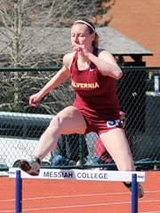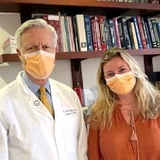A Dream Fulfilled: From Surgery as a Newborn to a Nurse in the ICU
A Dream Fulfilled: From Surgery as a Newborn to a Nurse in the ICU

When Children’s Hospital of Philadelphia opens its second hospital in King of Prussia, Pa., it won’t just be a milestone for the hospital. It will also fulfill the lifelong dream of 26-year-old Abigail Lackman, who underwent surgery at CHOP in her first few days of life and is now a nurse in the Hospital’s ICU.
The year was 1995. Fetal medicine pioneers N. Scott Adzick, MD, MMM, and Lori J. Howell, DNP, MS, RN, had recently arrived at Children’s Hospital of Philadelphia (CHOP) to establish one of the nation’s first fetal diagnosis and treatment centers.
Meanwhile, 60 miles northwest in Reading, Pa., Agnes Lackman was five months into a healthy pregnancy when back pain landed her in the hospital. An ultrasound found the cause of her pain: kidney stones. For good measure, the technician also did an ultrasound of the baby. What he saw was alarming: An abnormal mass of nonfunctioning lung tissue was forming inside of the fetus’ left chest but outside (extralobar) of the fetus’ lungs.
Agnes was referred to the Hospital of the University of Pennsylvania (HUP), which is in Philadelphia and immediately adjacent to CHOP. There, the diagnosis was confirmed as a large extralobar bronchopulmonary sequestration, a rare birth defect and one of several types of congenital lung lesions.
Agnes returned to HUP for weekly follow-up appointments for the remainder of the pregnancy to monitor the fetus’s health. During that time, the fetus developed a large pleural effusion, which is an accumulation of fluid in the chest that compresses the lungs and heart. The doctors at HUP performed a series of procedures to drain the fluid, but it kept re-accumulating. They then tried placing a thoracoamniotic shunt in the fetus’s chest to drain the fluid, but the shunt fell out.
The care team worried Agnes would go into early labor and her child would be born prematurely, with lungs too underdeveloped to function adequately after birth, so they put Agnes on bedrest to prolong the pregnancy as long as possible. Meanwhile, they consulted with Dr. Adzick and CHOP neonatologists to create a plan for delivery and postnatal care.
The plan was to deliver the baby at HUP, immediately resuscitate her, and then transfer her to CHOP’s Harriet and Ronald Lassin Newborn/Infant Intensive Care Unit (N/IICU). Once the child was stabilized, the lung lesion would be surgically removed.
Premature birth and the struggle to breathe
Abigail (Abby for short) was born early, at 33 and a half weeks, weighing just 4 pounds. She had a “very weak cry,” recalls her mother, and struggled to breathe. As planned, CHOP’s neonatal team was standing by and immediately got to work caring for Abby. They then quickly transferred her to the N/IICU through a passageway that connects the two hospitals.
Six hours later, Dr. Adzick visited Agnes’s bedside at HUP with a grim update. Despite the N/IICU team’s best efforts to get oxygen circulating through Abby’s body, nothing was working. A ventilator was not enough. The only option that remained was a treatment called extracorporeal membrane oxygenation (ECMO).
Abby’s prematurity and small size put her on the very edge of ECMO eligibility. Moving ahead with it required Agnes’s consent.
“He explained what ECMO was and said it was the only chance Abby had,” recalls Agnes. “She was really sick. It was very frightening.”
ECMO support saves the day
After seven days on ECMO, Abby wasn’t completely out of the woods, but her health was much improved. Three more weeks passed before she was strong enough to undergo a surgical procedure in which Dr. Adzick removed the piece of abnormal lung tissue in her chest.
The roller coaster ride of ups and downs continued for a month. When Abby was finally discharged home after spending a total of two and a half months in the N/IICU, she was on 24/7 oxygen and feeding tube support. She was weaned off both by age 1.
As Abby grew, she developed a condition called pectus excavatum, a deformity in which the breastbone sinks into the chest. In severe cases, it can interfere with the function of the heart and lungs.
Abby returned to CHOP for surgery to correct the condition at age 5. Dr. Adzick performed the minimally invasive Nuss procedure, using just two tiny incisions to attach a steel bar to her ribs to support her breastbone and correct the pectus excavatum.
Catching up, then zooming ahead
Agnes always wondered how Abby’s health conditions would affect her ability to do things like run and play sports. It took a little while for Abby to catch up to her peers in terms of her size, weight, motor skills and lung capacity. But when Abby was 7 and the steel bar was removed and she was cleared for full activity, Agnes “signed her up for everything.”

“She had a normal childhood after all those years of being weak and being behind,” says Agnes. “By the age of 10, she was caught up with everybody, and you would never know something had been wrong with her.”
In high school, Abby ran track and field. She also played field hockey, basketball and soccer.
“My endurance wasn’t always 100%,” she says, looking back. “But over time, my body compensated.”
She continued running track and field at Alvernia University in Reading, Pa., even setting a school record in the hurdles.
Living the dream
Growing up, Abby’s interactions with CHOP nurses and doctors made a huge impression on her. She’ll never forget the nurse who calmed her down before the pectus excavatum surgery by doing a Britney Spears sing-along.
“I was really scared, and she said, ‘Do you like Britney Spears?’ Then we started singing and I totally forgot that I had left my parents to go to surgery,” recalls Abby.
From that experience on, Abby didn’t just want to be a nurse, she wanted to be a “CHOP nurse.” Now, more than 20 years later, that dream has come true.

Six months ago, Abby began working as a nurse in CHOP’s Pediatric Intensive Care Unit (PICU), and she will be transferring to CHOP’s new hospital in King of Prussia when it opens later this month.
“She always had it in her mind that she would work at CHOP one day because the nurses were so nice,” says Agnes. “She would always say, ‘I’m going to be like them one day.’ And she did it. It’s amazing.”
It wasn’t until Abby started working in CHOP’s PICU that she realized just how critical her condition at birth had been. The experience compelled her to email the surgeon who made her life, and her dream, possible.
She wrote:
“Dr. Adzick,
I hope you are doing well. My name is Abigail Lackman. I was a patient of yours almost 26 years ago. I just wanted to let you know that I am now working in the pediatric intensive care unit at CHOP. Soon I will be going to the new hospital in KOP. I wanted to personally thank you for everything because I would not be here today without you. To think I was born premature and was on ECMO for seven days is crazy. Now that I understand the terminology, I understand how critical my condition was at the time. Now, I am healthy and working in my dream job as an ICU nurse in the hospital that saved me.”